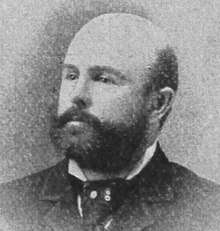Raff & Gammon
Raff & Gammon was a film distribution company founded by Norman C. Raff and Frank R. Gammon that ran during the silent film era. They are known for distributing and promoting some of the Edison Studio films,[1] and founding their own business, which was called The Kinetoscope Company.

History
Kinetoscope company
In August 1894, Raff & Gammon earned rights to start selling Kinetoscopes.[2] One of their employees, Alfred Clark, made the company more popular by making new movies. In 1895, the Kinetoscope started to fade and became less popular with new film technology being created.[3] In 1896, C. Francis Jenkins and Thomas Armat invented the Phantoscope. They showed the Phantoscope to Raff & Gammon, who were interested in it, so they agreed for the rights to the Phantoscope. They later showed this to the Thomas Edison Manufacturing Company, who started manufacturing the machine with permission.[4] They then renamed the machine "The Edison Vitascope". They founded the Kinetoscope company for exclusive rights for different territories and nations.[5]
Fall
The company began to fall in October 1896, when high-quality technology similar to the Phantoscope, and more customers purchased those instead. More specifically, the American Mutoscope Company (better known as the Biograph Company), had produced a new motion picture system, which used more surface area than the Phantoscope. Shortly afterwards, the Biograph became more successful, and Raff & Gammon collapsed by the end of 1897.[6] The rights to the vitascope was bought by George W. Llewellyn shortly before the company ended.[7]
Filmography
Source:[8]
- The Pickaninnies (1894)
- Barber Shop (1895)
- The Kiss (1896)
References
- "Raff and Gammon Collection". www.library.hbs.edu. Retrieved 2020-02-08.
- Balio, Tina (1976). The American Film Industry. The University Of Wisconsin Press. p. 66.
- "Who's Who of Victorian Cinema". www.victorian-cinema.net. Retrieved 2020-02-08.
- "(1895-1896)". Library Of Congress. Retrieved 8 February 2020.
- "Guide to Motion Picture Catalogs - The Edison Papers". edison.rutgers.edu. Retrieved 2020-05-14.
- "Before the Nickelodeon". publishing.cdlib.org. Retrieved 2020-05-21.
- Musser, Charles; Nelson, Carol (2015-03-08). High-Class Moving Pictures: Lyman H. Howe and the Forgotten Era of Traveling Exhibition, 1880-1920. Princeton University Press. ISBN 978-1-4008-7272-5.
- "Raff and Gammon". BFI. Retrieved 2020-05-21.